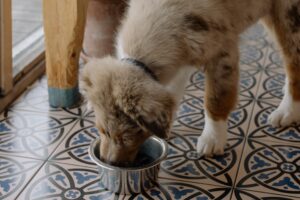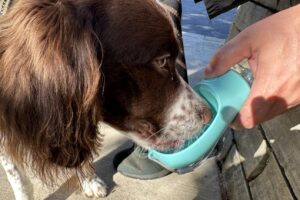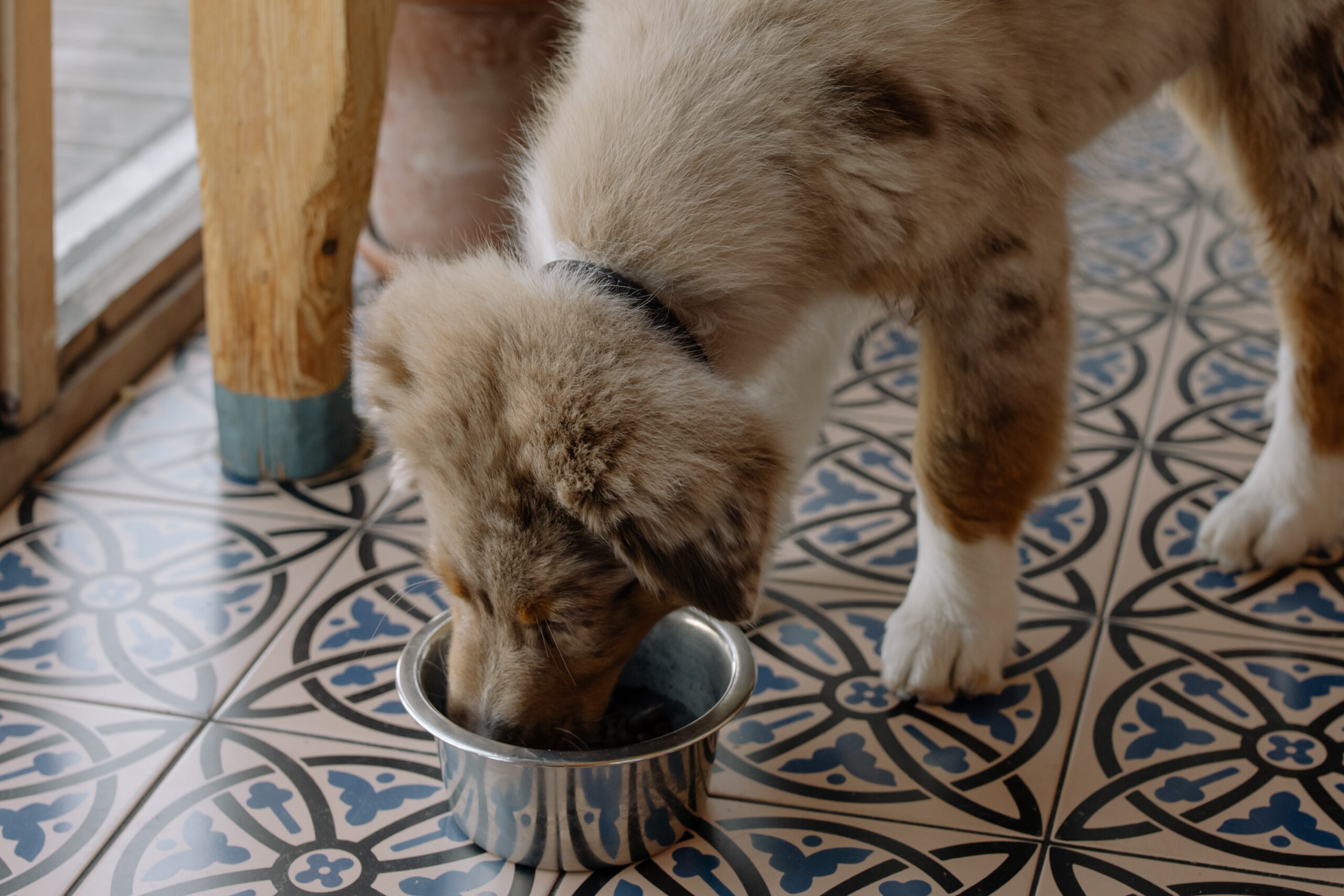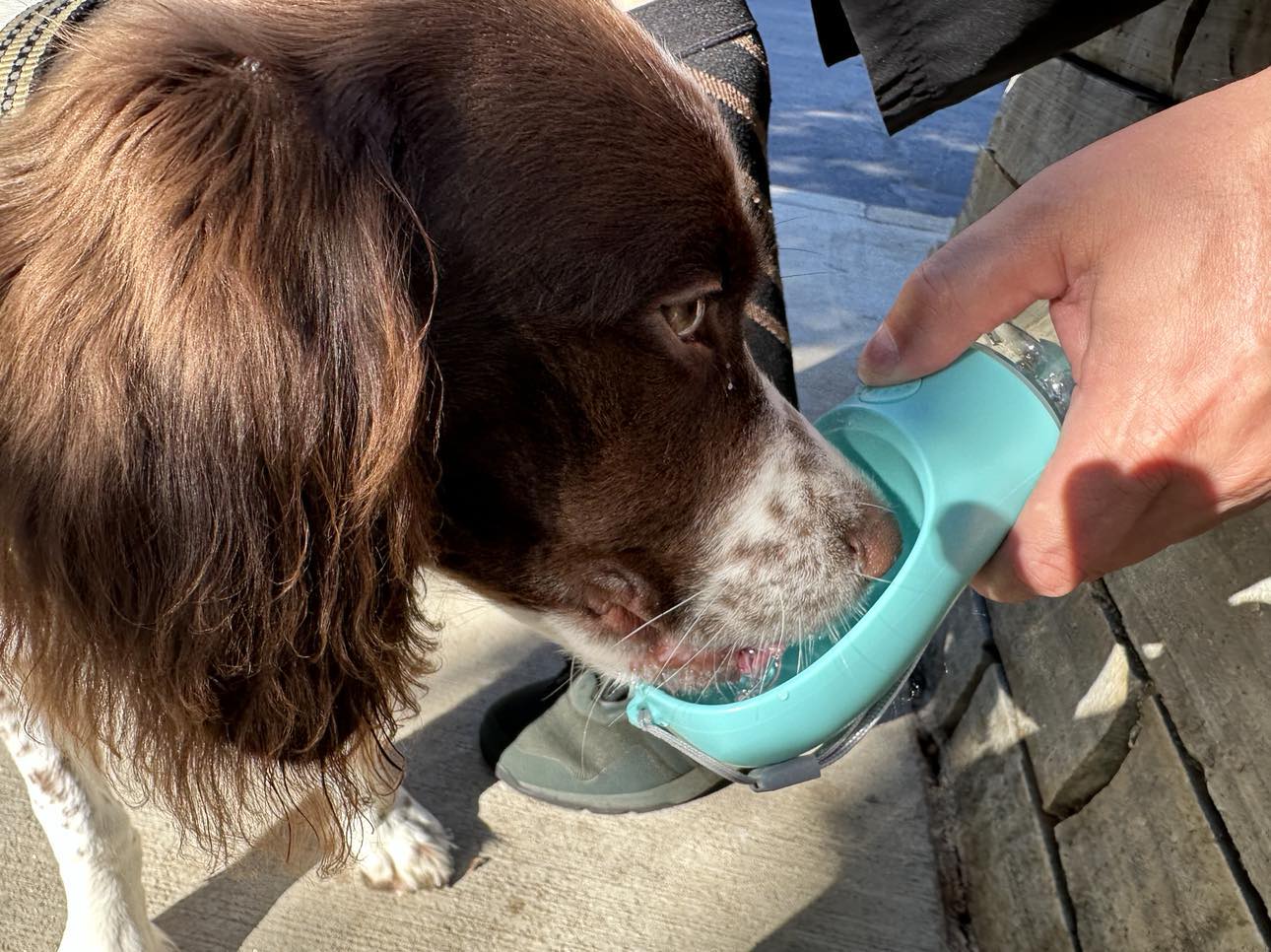From the moment a playful, wide-eyed puppy takes its first nibble of kibble, an intricate and captivating journey begins within its tiny body. The wonder of how that innocent meal transforms into waste, a vital aspect of every living being’s existence, is a subject that has intrigued scientists, pet owners, and curious minds alike. Delving into the depths of a puppy’s digestive system opens a gateway to comprehending the intricate dance of enzymes, organs, and biological processes that sustain these furry companions.
As responsible pet owners, understanding the inner workings of a puppy’s digestive process goes beyond mere curiosity. It empowers us to make informed decisions that directly impact our furry friends’ health and well-being. A sound grasp of digestion aids in selecting appropriate diets, recognizing signs of potential issues, and establishing routines that promote optimal nutrient absorption and waste elimination. Just as a well-balanced diet nourishes a puppy’s growth, knowledge about digestion nurtures a strong foundation for their overall health.
Embarking on this exploration, our article is structured to unravel the mystery of how a puppy’s meal metamorphoses into waste. We’ll begin by acquainting ourselves with the basics of the canine digestive system, offering insight into the key organs and processes involved. Building upon this foundation, we’ll journey through the various phases that unfold after a meal, leading us to the moment when a puppy signals its need to poop. Along the way, we’ll highlight the factors influencing a puppy’s pooping patterns and delve into the behaviors and signals that reveal when nature calls. As we traverse the landscape of digestion, we’ll also address common digestive issues and provide guidance for maintaining a healthy digestive system in your furry companion. By the time we reach our destination, you’ll have gained a deeper appreciation for the intricate dance of biology that underpins a puppy’s everyday routine. So, without further ado, let us embark on this enlightening journey through the digestive world of puppies.
The Canine Digestive System: Basics and Anatomy
Unveiling the Inner Mechanisms: Brief Overview of the Canine Digestive System
The canine digestive system is a marvel of biological engineering, finely tuned to process a puppy’s meals and extract vital nutrients while efficiently eliminating waste. Like a symphony of coordinated actions, this system ensures that every morsel of food consumed is broken down, absorbed, and converted into energy or building blocks for growth.
Key Players in the Digestive Orchestra: Organs at Work
- Mouth: The journey begins as a puppy eagerly munches on its meal. The mouth is the gateway to digestion, where food is mechanically broken down through chewing while being mixed with saliva containing enzymes that initiate the breakdown of carbohydrates.
- Stomach: The chewed food, now referred to as “chyme,” moves to the stomach—a muscular organ where it encounters gastric juices, including hydrochloric acid and enzymes like pepsin. These powerful substances further break down proteins and sterilize the ingested material.
- Small Intestine: As the chyme leaves the stomach, it enters the small intestine—a critical site for nutrient absorption. The lining of the small intestine is lined with finger-like projections called villi, which increase the surface area for absorption. Enzymes from the pancreas and bile from the liver aid in breaking down fats, carbohydrates, and proteins into smaller molecules that can be absorbed into the bloodstream.
- Large Intestine: Once nutrients are extracted, the remaining material enters the large intestine, where water is reabsorbed, consolidating the waste into a more solid form. This is also where beneficial gut bacteria play a crucial role, aiding in the fermentation of undigested carbohydrates and producing certain vitamins.
- Rectum: The waste, now transformed into feces, is stored in the rectum until it is ready for elimination through the anus.
Digestion’s Collaborative Duo: Role of Enzymes and Gut Bacteria
- Enzymes: Just as an orchestra conductor guides the musicians, enzymes orchestrate the breakdown of food. These specialized proteins act as catalysts, accelerating chemical reactions that break down complex nutrients into simpler forms. Enzymes originating from various sources, such as the salivary glands, stomach, pancreas, and small intestine, work harmoniously to ensure efficient digestion.
- Gut Bacteria: Beneath the surface of this digestive symphony lies an ensemble of gut bacteria. These microscopic partners aid in the breakdown of certain indigestible compounds, synthesize essential nutrients, and play a role in maintaining a healthy gut environment. The delicate balance of these bacterial communities contributes to a puppy’s overall well-being.
As we delve deeper into our exploration, we’ll witness the seamless interplay between these digestive components, providing insight into the fascinating journey from a puppy’s initial bite to the moment it signals a need to relieve itself. Stay with us as we continue our voyage through the digestive wonderland of puppies.
The Process of Eating: From Food to Nutrients
Ingestion: Chewing, Saliva Production, and Swallowing
Imagine a puppy eagerly approaching its bowl, ready to embark on a gastronomic adventure. The process begins with ingestion, a captivating series of actions that kickstart the journey of turning a delectable meal into vital nutrients. As the puppy chews, its teeth grind and tear the food, breaking it down into smaller, more manageable pieces. This mechanical breakdown not only aids in digestion but also exposes a larger surface area for enzymes to work their magic.
The puppy’s salivary glands are next in line, releasing a watery elixir containing enzymes like amylase. These enzymes initiate the breakdown of carbohydrates, converting complex starches into simpler sugars. As the mastication continues, the puppy swallows the softened food, sending it on its way to the stomach.
Stomach: Acidic Environment, Breaking Down Food into Chyme
Upon reaching the stomach, the chewed and enzymatically treated food encounters a harsh acidic environment. The stomach’s powerful gastric juices, including hydrochloric acid and pepsin, work together to reduce the food to a semi-liquid mixture called chyme. This transformative process not only further breaks down proteins but also sterilizes the incoming material, ensuring harmful microorganisms are neutralized.
The stomach’s muscular walls churn and mix the chyme, aiding in the uniform distribution of gastric juices. This mechanical action contributes to the breakdown of larger particles and helps create an ideal consistency for onward passage to the small intestine.
Small Intestine: Nutrient Absorption and Transport to the Bloodstream
The chyme, now processed and liquefied, moves into the small intestine, the master absorptive site of the digestive journey. The small intestine is a marvel of adaptation, with its inner surface resembling a velvety tapestry adorned with countless finger-like villi. These villi are covered in even tinier projections called microvilli, creating a vast surface area for nutrient absorption.
As the chyme travels through the small intestine, enzymes from the pancreas and bile from the liver continue the breakdown of nutrients. Carbohydrates, proteins, and fats are broken down into glucose, amino acids, and fatty acids, respectively. These tiny building blocks are then absorbed through the walls of the small intestine and transported into the bloodstream, where they become the energy currency that fuels the puppy’s growth, development, and daily activities.
The orchestrated dance of enzymes, acidic environments, and the intricate structures of the small intestine culminates in the extraction of life-sustaining nutrients, marking a pivotal point in the puppy’s digestive odyssey.
As we marvel at the seamless integration of mechanical and chemical processes that transform a puppy’s meal into nourishing sustenance, we’ll continue our exploration, delving deeper into the later phases of digestion. Join us as we journey through the winding corridors of the digestive system, uncovering the hidden secrets behind nutrient absorption and waste elimination.
Post-Meal Digestive Phases and Potty Time
Gastric Emptying: Passage of Chyme from the Stomach to the Small Intestine
With the nutrients effectively extracted in the stomach, the chyme now moves on to the next phase of the digestive journey—gastric emptying. This intricate process involves the gradual release of chyme from the stomach into the small intestine. Gastric emptying is a finely tuned mechanism, ensuring that the small intestine receives a manageable amount of chyme for optimal nutrient absorption.
The rate of gastric emptying is influenced by factors such as the composition of the meal, the puppy’s age, and the puppy’s overall health. This careful orchestration allows the small intestine to efficiently process and absorb the nutrients that the growing puppy requires.
Nutrient Absorption: Essential Nutrients Entering the Bloodstream
As the chyme enters the small intestine, the real magic of digestion unfolds—nutrient absorption. The villi and microvilli lining the walls of the small intestine play a pivotal role in this process, acting like tiny gatekeepers that selectively allow nutrients to pass through.
Glucose, amino acids, and fatty acids, the building blocks of energy and growth, are absorbed into the bloodstream through the walls of the small intestine. This intricate network of nutrient highways ensures that these vital elements are swiftly transported to cells throughout the puppy’s body, fueling its growth and sustaining its activities.
Large Intestine: Water Reabsorption and Formation of Feces
With the majority of nutrients absorbed, the chyme enters the large intestine, a crucial region where water reabsorption takes place. The large intestine is equipped with a unique array of bacteria that continue to aid in digestion, particularly in the fermentation of carbohydrates that weren’t fully broken down earlier in the process.
During the passage through the large intestine, excess water is reabsorbed from the chyme, gradually transforming it into a more solid consistency. This controlled dehydration is essential to prevent excessive fluid loss in the body and to create the foundation for the formation of feces.
Rectum: Storage of Feces Before Elimination
The journey of digestion nears its completion as the now-formed feces move into the rectum, the terminal portion of the large intestine. Here, the rectum acts as a holding chamber, temporarily storing the waste material until it’s ready for elimination.
The sensory receptors in the rectum monitor the volume and consistency of the feces, sending signals to the puppy’s brain when it’s time for a bathroom break. This intricate communication between the digestive system and the nervous system ensures that the puppy is able to signal its need to relieve itself.
As we traverse the latter phases of digestion, we witness the culmination of a remarkable journey that converts a meal into nourishment and prepares the body for waste elimination. Join us in the next section as we explore the factors that influence a puppy’s pooping patterns and unravel the subtle cues that reveal when it’s time for potty time.
Factors Influencing Puppy Pooping Patterns
Diet Composition: Impact of Different Nutrients and Ingredients
The old adage “you are what you eat” rings particularly true in the world of puppies and their digestive patterns. The composition of a puppy’s diet plays a pivotal role in determining the frequency, texture, and ease of elimination. Puppies consuming a diet rich in high-quality proteins, fibers, and essential nutrients tend to have well-regulated digestive processes, resulting in healthy and regular pooping patterns. On the other hand, an imbalanced diet lacking in crucial nutrients can lead to digestive discomfort, irregularity, and even issues like constipation or diarrhea.
Portion Size: How the Amount of Food Affects Digestion and Elimination
The quantity of food a puppy consumes in each meal directly impacts its digestive journey. Overfeeding can overwhelm the digestive system, leading to incomplete digestion, sluggish bowel movements, and even strain on the puppy’s organs. Conversely, portion sizes that are too small might lead to insufficient nutrient absorption and irregular elimination. Finding the right balance between portion size and nutrient content is essential for maintaining healthy pooping patterns.
Age and Size: Developmental Changes in Puppies’ Digestive Systems
Puppies, like humans, undergo significant developmental changes as they grow. Their digestive systems are no exception. Younger puppies may have more frequent bowel movements due to their rapid metabolism and the smaller capacity of their digestive tracts. As puppies mature, their digestive systems adapt, leading to changes in pooping frequency and consistency. Additionally, the size of the puppy can influence the volume and frequency of waste produced.
Breed Variations: Unique Digestive Traits in Different Breeds
Just as each breed boasts distinctive physical characteristics and temperaments, they also exhibit unique digestive traits. Some breeds may have a predisposition to certain digestive issues or intolerances, influencing their pooping patterns. For instance, brachycephalic breeds with shorter noses may swallow more air during meals, potentially leading to increased flatulence or digestive discomfort. Being aware of breed-specific digestive tendencies allows puppy owners to tailor care to their pet’s individual needs.
Understanding these factors provides crucial insights into a puppy’s pooping patterns and can help identify any deviations from the norm. As we continue our journey through the complexities of digestion, we’ll unravel the behaviors and signals that offer a window into a puppy’s digestive health. Join us in the next section as we delve into the world of puppy behavior during potty time and learn to decode their unique communication cues.
The Pooping Process: Puppy Behavior and Signals
Indications of Impending Bowel Movement
Just as humans exhibit certain cues before using the restroom, puppies also display subtle behaviors that signal an impending bowel movement. Observing your puppy’s actions can help you anticipate when it’s time for them to relieve themselves. Some common indications include sniffing the ground, circling or pacing, restlessness, and even whining. Recognizing these signs allows you to be proactive in providing a suitable place for your puppy to do their business.
Factors Affecting Poop Frequency: Age, Diet, Exercise
A puppy’s poop frequency can vary based on several factors, offering insights into their overall well-being. Younger puppies tend to eliminate more frequently due to their developing digestive systems and higher metabolism. Diet plays a substantial role, as a well-balanced and nutrient-rich diet promotes efficient digestion and regular elimination. Adequate exercise also stimulates the digestive system, potentially leading to more predictable pooping patterns.
Understanding a Puppy’s Body Language During Potty Time
The art of deciphering a puppy’s body language during potty time is akin to understanding a secret code. Puppies communicate their needs and intentions through a range of physical cues. A puppy that’s ready to poop may exhibit behaviors such as sniffing the ground, circling, squatting, or even making a specific expression or noise. Recognizing these signals enables you to guide your puppy to an appropriate spot and reinforce positive bathroom habits.
Additionally, accidents can happen, especially during the housetraining phase. Rather than scolding your puppy, it’s important to remain patient and understanding. Establishing a consistent routine and praising your puppy for successful eliminations will contribute to their understanding of where and when it’s appropriate to poop.
As we delve deeper into the intricacies of a puppy’s pooping behavior, we unearth a wealth of information encoded in their actions. By learning to interpret these signals and responding with care and consideration, you foster a harmonious relationship with your furry companion and contribute to their overall health and happiness. Join us in the following section as we shed light on common digestive issues and abnormalities that might affect your puppy’s pooping patterns, along with guidance on how to address them effectively.
Common Digestive Issues and Abnormalities
Diarrhea: Causes, Symptoms, and Remedies
Diarrhea, characterized by loose or watery stools, is a common digestive concern that can affect puppies. It can be caused by a variety of factors, including dietary changes, food allergies, infections, stress, or parasites. Watching for signs of diarrhea, such as increased frequency of bowel movements, urgency, and changes in stool consistency, is crucial for early intervention.
If your puppy experiences diarrhea, it’s important to ensure they stay hydrated to prevent dehydration. Gradually transitioning to a bland diet of easily digestible foods like plain boiled rice and boiled chicken can help soothe their stomach. However, persistent or severe diarrhea warrants a visit to the veterinarian to determine the underlying cause and receive appropriate treatment.
Constipation: Identifying and Addressing the Issue
On the flip side, constipation occurs when a puppy has difficulty passing stools, often resulting in dry and hard feces. Factors like insufficient water intake, lack of dietary fiber, or underlying medical conditions can contribute to constipation. Straining to defecate, infrequent or small stools, and signs of discomfort are indicators of constipation.
If you suspect your puppy is constipated, increasing their water intake and adding fiber-rich foods like canned pumpkin to their diet can help alleviate the issue. However, persistent constipation should be discussed with a veterinarian to rule out any underlying health problems and receive appropriate guidance.
Gastrointestinal Disorders: When to Seek Veterinary Help
While occasional digestive issues are common, persistent or severe problems may indicate a more serious gastrointestinal disorder. Puppies with chronic vomiting, blood in stools, dramatic weight loss, or consistent changes in appetite should be evaluated by a veterinarian. Gastrointestinal disorders such as gastritis, pancreatitis, or inflammatory bowel disease require professional diagnosis and treatment.
Timely veterinary care is crucial for accurate diagnosis and effective management of gastrointestinal disorders. Your veterinarian may recommend diagnostic tests such as blood work, fecal analysis, or imaging to determine the root cause of the problem.
Understanding these common digestive issues empowers puppy owners to take proactive steps in promoting their pet’s digestive health. By recognizing symptoms early and seeking appropriate veterinary care, you can help your puppy navigate through potential digestive challenges and ensure their well-being. As we approach the conclusion of our journey, we’ll provide valuable tips to maintain a healthy digestive system in your furry friend. Join us in the next section as we explore key practices for responsible puppy care and digestive wellness.
Healthy Digestion: Tips for Puppy Owners
Choosing a Suitable Puppy Food: Factors to Consider
The foundation of a puppy’s digestive health begins with the food they consume. Selecting a high-quality puppy food that meets their specific nutritional needs is paramount. Look for well-balanced options that provide essential nutrients such as proteins, carbohydrates, healthy fats, vitamins, and minerals. Consult with your veterinarian to determine the most appropriate food based on your puppy’s age, size, breed, and any specific health considerations.
Establishing a Regular Feeding Schedule
Consistency is key when it comes to fostering healthy digestion. Establishing a regular feeding schedule helps regulate your puppy’s digestive processes and eliminates the likelihood of overeating or undereating. Puppies thrive on routine, so aim to feed them at the same times each day. Dividing their daily food intake into multiple smaller meals can also aid digestion by reducing the strain on their stomach.
Hydration: Importance of Providing Clean, Fresh Water
Adequate hydration is essential for maintaining optimal digestive function. Ensure your puppy has constant access to clean, fresh water. Hydration supports digestion, helps prevent constipation, and aids in the absorption of nutrients. During hot weather or after physical activity, pay extra attention to their water intake to prevent dehydration.
Monitoring and Adjusting Portion Sizes
Puppies’ nutritional needs evolve as they grow, and monitoring their portion sizes is crucial to avoid overfeeding or underfeeding. Follow the feeding guidelines provided on the puppy food packaging, but also be attentive to your puppy’s individual cues. If your puppy is consistently leaving food in their bowl or appears hungry after meals, consider adjusting the portion size accordingly. Regularly consulting with your veterinarian ensures that your puppy’s diet aligns with their changing needs.
By implementing these tips, you lay the groundwork for a robust and well-functioning digestive system in your puppy. Your proactive approach to responsible puppy care not only contributes to their physical health but also enhances their overall quality of life. As we conclude our journey through the intricate realm of a puppy’s digestion, we invite you to reflect on the newfound knowledge you’ve gained and apply it to nurturing a strong and resilient companion.
Conclusion
Recap of the Puppy’s Digestive Journey After Eating
Our voyage through the intricate world of a puppy’s digestion has uncovered a remarkable sequence of events that unfold after each meal. From the moment a puppy takes its first bite to the eventual elimination of waste, a symphony of organs, enzymes, and processes collaborate to ensure the transformation of food into vital nutrients. We’ve traced the path from the mouth, where chewing and saliva begin the breakdown, through the stomach’s acidic realm, the nutrient-rich small intestine, the water-reabsorbing large intestine, and finally, the rectum, where waste is temporarily stored. Each phase contributes to a harmonious dance that sustains your puppy’s growth and well-being.
The Significance of Understanding the Process for Responsible Puppy Care
Knowledge truly empowers, especially in the realm of puppy care. Understanding the intricacies of a puppy’s digestive process equips you with the tools to provide optimal care. By recognizing the factors influencing pooping patterns, interpreting your puppy’s cues, and addressing common digestive issues, you become a knowledgeable and attentive caregiver. Your ability to make informed decisions about diet, feeding routines, and hydration ensures that your puppy thrives and leads a comfortable and fulfilling life.
Encouragement for Puppy Owners to Observe, Learn, and Maintain a Healthy Digestive System in Their Pets
As a responsible puppy owner, you hold the key to your furry friend’s well-being. We encourage you to observe and learn from your puppy’s behaviors and signals. By honing your ability to interpret their needs, you can create a positive environment that promotes digestive health. Maintain open communication with your veterinarian, utilize the tips shared, and adjust your approach as your puppy grows and evolves. Your commitment to nurturing a healthy digestive system will undoubtedly contribute to a long and joyful companionship.
In closing, the journey we embarked upon—exploring the path from food to nutrients to waste—unveils the elegance and complexity of a puppy’s digestive process. By embracing this knowledge, you not only deepen your bond with your furry companion but also champion their wellness. As you watch your puppy play, eat, and, yes, poop, you do so with newfound admiration for the wondrous mechanisms that keep their world turning










